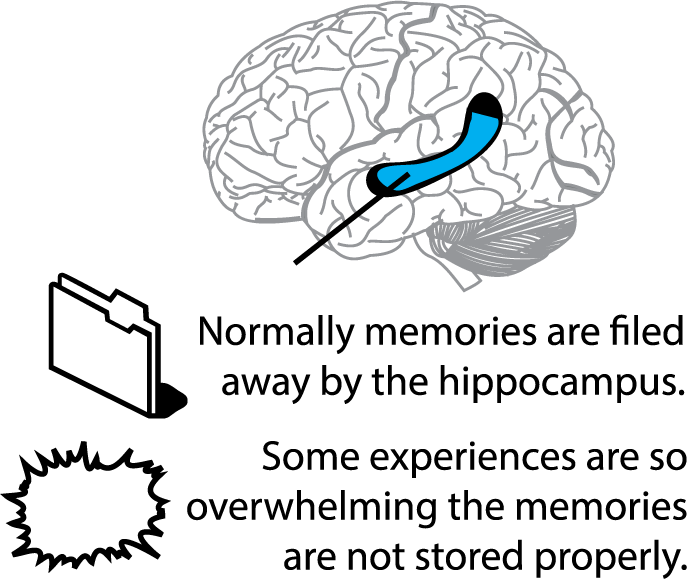Original information handout from Psychology Tools
Introduction
Eye Movement Desensitisation and Reprocessing (EMDR) is a psychotherapy approach designed for working with distressing or traumatic memories. The theory behind EMDR is that many psychological difficulties are the result of distressing life experiences which have not been stored in memory properly and are said to be unprocessed or blocked. These traumatic memories may need some help to become processed, and EMDR is one way to do this.
What is special about trauma memories?
Normal memories are stored by a part of the brain called the hippocampus. You can think of the hippocampus as a sort of librarian which catalogues (processes) events and stores them in the right place. However, some traumatic events (such as accidents, abuse, disasters, or violence) are so overwhelming that the hippocampus doesn’t do its job properly. When this happens memories are stored in their raw, unprocessed, form. These trauma memories are easily triggered, leading them to replay and cause distress over and again.

What will I be asked to do in an EMDR session?
There are a number of steps to EMDR treatment, but some of the key stages are to:
| Preparation phase: | • Think of a troubling memory, then identify an image of the worst moment of that memory. • Identify a negative belief about that worst moment (the therapist may ask “what is the worst thing that moment says about you?”). • Identify emotions and bodily feelings linked to that moment. |
| Processing phase: | • Think about the image & belief while at the same time making left-to-right eye movements (or while paying attention to tapping sensations or sounds that are alternately given from left-to-right). • To allow your mind to ‘go with’ whatever comes up and just notice what happens. • This process will be repeated until the memory causes less distress (this may happen in one session, or may take more than one session). |
Why do I need to make eye movements?
In EMDR you are asked to pay attention from one side to another while thinking about your memory. One way to pay attention from left to right is to follow the therapist’s finger as they move it from side-to-side in your line of vision. Alternative versions of EMDR ask you to pay attention to sounds or tapping sensations which occur in sequence from left to right.

This side-to-side motion is called bilateral stimulation. It has been found to enhance memory processing and there are a number of theories explaining how it might do this. The important thing is to be able to find a form of bilateral stimulation that you are comfortable with.
What is EMDR used to treat?
Research has demonstrated that EMDR is effective for the treatment of Post-Traumatic Stress Disorder (PTSD), as well as low mood and depression, anxiety and anxiety disorders, stress, panic attacks, phobias, abuse, disturbing memories, addictions, complicated grief and chronic pain.
The validity and reliability of EMDR has been established by rigorous research. There are now over nineteen controlled studies into EMDR, making it the most thoroughly researched method used in the treatment of trauma, and The American Psychiatric Association, American Psychological Association, Department of Defense, Veteran’s Administration, insurance companies, and the International Society for Traumatic Stress Studies recognize EMDR as an effective treatment for PTSD
How long does treatment take?
EMDR sessions are sometimes slightly longer than typical therapy sessions (up to 90 minutes). The number of sessions needed will depend on the type and severity of trauma which you experienced. As a rough guideline NICE estimate that 8-12 sessions may be sufficient to treat simpler traumas, with more sessions necessary for multiple traumas.




